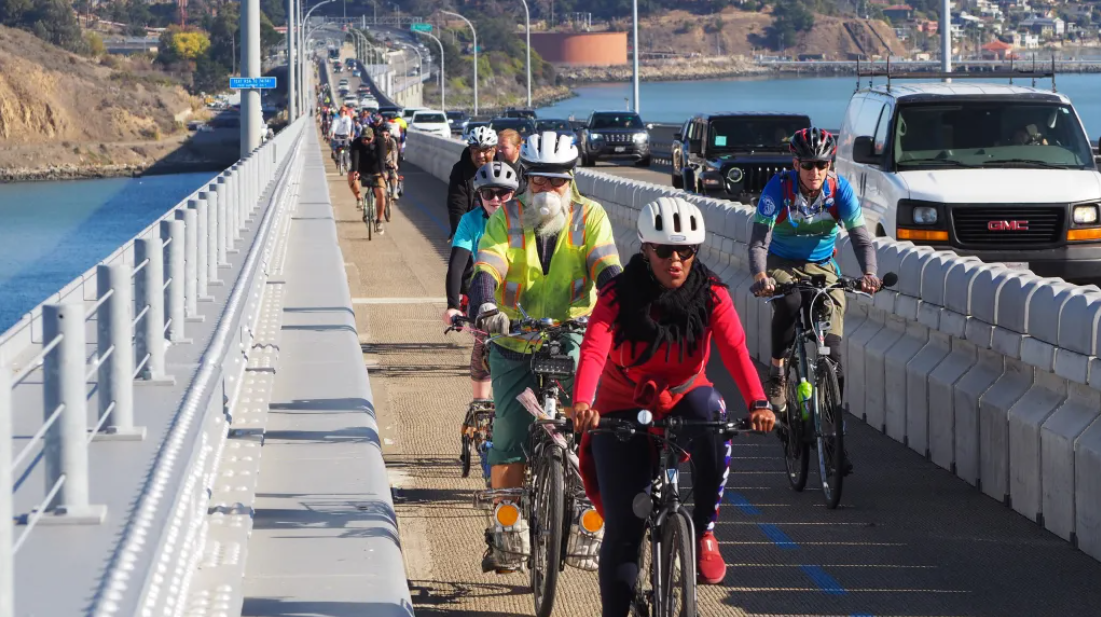Hairball Study Coughs Up Ideas, Memories
12:33 PM PST on February 19, 2010
 Click to enlarge. Bird’s-eye view of the hairball shows how much real estate it takes up and how it creates a daunting barrier between neighborhoods. Photo: mike.teczno.com.
Click to enlarge. Bird’s-eye view of the hairball shows how much real estate it takes up and how it creates a daunting barrier between neighborhoods. Photo: mike.teczno.com."You can't get there from here" is a joke phrase, but trying to travel through the Highway 101 freeway maze at Cesar Chavez/Potrero/Bayshore is no laughing matter. Four neighborhoods meet at the maze, known as the "hairball": Potrero Hill, Bayview, Bernal Heights, and the Mission. But moving from one to another without a car is scary indeed.
Now, city officials are teaming up with residents to plan a redesign of the aging structure that could encourage neighbors to visit one another on foot and by bicycle. A Planning Department award, announced in September, will fund a study
of the maze to tap into the ideas of locals who have to live with it.
As the freeway approaches the end of its natural life, neighbors fear
that without an alternative plan, Caltrans will simply replace the old
freeway with basically the same design.
Potrero was reconfigured in 2005, from six car lanes to four, with new left-turn pockets, bike lanes, and crosswalk enhancements. Bayshore and eastern Cesar Chavez are both slated to be restriped with bike lanes as part of the citywide bike plan. Western Cesar Chavez has inspired an ambitious Planning Department redesign that will create a landscaped median and changes similar to those on Potrero. All four roadways, however, feed into the notorious churning maze, leaving cyclists and pedestrians dashing across on and off-ramps and skulking along dark, threatening pathways.
The hairball wasn't always so forbidding. Bonnie Ora Sherk, president and founding director of Crossroads Community (The Farm), recalls holding musical offerings, poetry readings, art installations, dance performances, and public gatherings there. She planted lush gardens with local school children in the 1970s in the belly of the maze, the site under which the Islais, Precita, and Serpentine Creeks converge. Crossroads Community was so named by Sherk to be a place for people from the four surrounding communities to come together where the freeway had severed them.
Adjacent to the freeway interchange were multiple gardens on state and private land. In the complex of The Farm buildings was The Raw Egg Animal Theater, the indoor/outdoor home of the farm animals who lived at The Farm and a spectacular school-without-walls for all ages. The Farm, including the interchange, was one of the first alternative art spaces in the country and also a thriving multicultural community environmental education center. It inspired Potrero del Sol Park.
"We have an excellent opportunity now to transform the current dilapidated, unsafe, and scary maze into a healthy place for people, other species, and even cars," Sherk said. "It can reconnect people to the currently hidden ecological resources so prevalent at the site."
 An art installation tucked in the freeway maze last summer featured hidden objects, paintings, and these hand-sewn custom pink cushions on the bleak Bayshore/Potrero connector. By Cameron Kelly. Photo by Carrie Galles.
An art installation tucked in the freeway maze last summer featured hidden objects, paintings, and these hand-sewn custom pink cushions on the bleak Bayshore/Potrero connector. By Cameron Kelly. Photo by Carrie Galles.The maze, opened in 1974, was intended to connect with the proposed Army Street (old name of Cesar Chavez) freeway to the Southern Crossing Bridge. The freeway revolt stopped that project, but the design of the interchange still reflects the original intention, making it much more complicated and extensive than is necessary.
The Planning Department study funding comes from a pot of Caltrans environmental justice grants. Other similar grants address mobility issues on Indian reservations and low-income communities in small towns and cities throughout the state. The Cesar Chavez/hairball funding amounts to $250,000. Another grant of $247,050 funds environmental reviews for Eastern Neighborhoods transportation projects. Andres Power of the Planning Department expects community meetings to begin in spring 2010.
"We were all very excited to hear that the city had been awarded this important grant from Caltrans," he said. "The community and various agencies have been working tirelessly on a redesign for Cesar Chavez Street west of the hairball, but we always knew that a design that stopped at the freeway was not the best we could do. With these Caltrans funds, we'll be able to think about connections through the hairball for people, cyclists, and vehicles all the way to the Bay."
Homeless people have long found refuge under the freeway ramps, and advocates for a better hairball must grapple with the question of how a redesign would affect these residents. The presence of their encampments in the maze has already led to some false solutions. Just sweeping the area of campers won't make it more welcoming. A completely deserted dark walkway is hardly more inviting than a dark walkway lined with shopping carts and their owners.
Proposals that focus on removing homeless people also play into divisions between some neighbors who may demonize poor people and others who resent any changes that smack of gentrification. The issue of what to do with a wide swath of dead space hostile to non-motorized travelers gets lost.
The problem isn't the homeless encampment. It's the lack of foot traffic and the secluded nature of the pathways, which make walking or cycling through feel creepy and unsafe, especially after dark. Opening up the passages and encouraging their use for people traveling from one neighborhood to another would mean that, at last, you can get there from here.
Stay in touch
Sign up for our free newsletter
More from Streetsblog San Francisco
Commentary: Merchants Are Getting People Killed
The number one local obstruction to curbing traffic violence is commerce and merchant groups.




